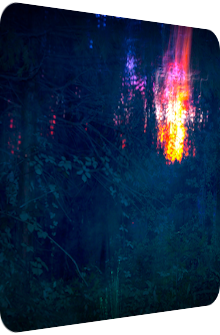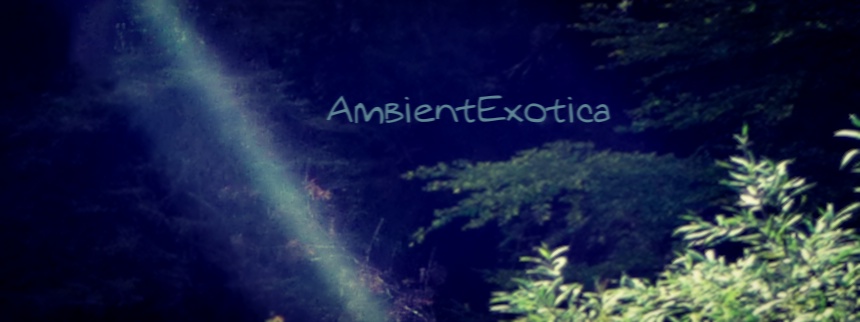
Betacicadae
Mouna
2013
Mouna is the debut by sound artist and photographer Kevin Scott Davis aka Betacicadae or Beta Cicadae, two years in the making and released in April 2013 on the Puerto Rico-based Elegua Records label in three distinct clear vinyl and CD editions of 100 copies each. The curator of the label and an artist himself, David Font-Navarrete, contacted me sometime in the latter half of 2012, and it was then settled to weave a work of Elegua’s catalog into my review schedule. Even better that it happens to be Betacicadae’s debut, I believe. The title Mouna is rooted in Sanskrit and means silence or revelation. Davis may have struggled and eventually found many of the possible meanings of these words, but neither the former silence, nor the latter revelation are served on a silver platter. Eight tracks in total made it onto the album, a work whose style is hard to pinpoint given the wide range of used instruments, their textures and the omnipresent impression of moving forwards, potentially leaving cozy places in favor of darker locations. A lot of the album’s parts were recorded in a forest and a farm in Sheridan, Oregon. They were then assembled and mixed in Portland. So when I write that the style is hard to grasp or jot down in comprehensible words, what could be the main reason for my befuddlement? It turns out that Betacicadae weaves lots of purposeful contradictions into the arrangements scattered with field recordings. Glistening vibraphones, guitar drones, wind chimes, violins and synths become entangled, their different tonal ranges and the created atmospheres are oftentimes incompatible with each other. Especially the work on the guitar is truly amazing, shimmers in Oriental colors, becomes entirely masked at other times. But these impressions are, in the end, purely technical and do not capture another interesting theme of the release: traveling. I have hinted at this concept of progression a few sentences before, but it becomes particularly clear on the vinyl version. Side A is much cozier whereas side B is dark, sometimes even amazingly so. No catchy melodies appear on the album, but fear not, for it is the textures that make the tone sequences memorable. These small protuberances and eruptions hit the listener like flashing bolts akin to the colorful rays on the front artwork which illuminate the darkness. I dared to take the journey Kevin Scott Davis offers numerous times. Can I nonetheless distill a reason or trend despite the murkiness? And if not: how to cope with this?
The opener Pahoa showcases the wealth of different textures and timbres right from the get-go, and although it launches with eerie-claustrophobic sine tone waves traversed by microscopic shifts and a stereo-panned iridescence, it soon ennobles its gelid aura with scintillating polar lights, field recordings of the nocturnal fauna and an airy whitewashed pink noise trajectory, itself encapsulated in tape hiss and brazen hi-hats. The voluminosity then grows and swells, Pahoa reaches its Shoegaze phase. Abyssal piano chords, pouring rain, a mystical ocarina-evoking two-note motif and a gently floating stream of darkness surround the listener and form the counterpoint to the fragile opening phase. Kevin Scott Davis manages to create an aura of stormy calm, the implied half tones are in major, spacey spirals accentuate the intensive dreaminess, no frightening element is unleashed (for now!), everything is stentorian yet soothing. The final phase consists of the lingering sound of golden shimmering guitar melodies in front of a pitch-black backdrop. The unsurprisingly short Strange Interlude relies on the same surfaces, but ventures into decidedly enigmatic paths without becoming labyrinthine or overly harsh. A snoring brutish sound layer is perturbed by luminescent wind chimes and whistles whereas dental drills, klaxon square leads and dark matter pads unite the 8-bit charm with belly-massaging drone runlets. The melodic traces are again of the good-natured kind, but once they grow thinner over the short course of the runtime, so does the amicability.
It is the following all too short Seti that returns to the more snugly implications of a chime-laden arrangement; in this case, Davis uses a proper vibraphone in adjacency to classic cymbals and allows each tone to sustain and conflate with the darkness, thereby creating a lucent ignis fatuus whose vacillating susurration becomes more spectral as the vignette progresses. The sudden approach of chirping nightingales links this tune to the overarching scheme of a moon-lit copse, but I wonder why this field recording is not injected throughout Seti’s duration rather than appearing out of nowhere in the second half? This is only a minor quibble, as the ambience of Seti is languorous and positively anodyne. Gold Country is next and the plinking construction of the album, with glittering guitar chords opposing Oriental mosquito-esque strumming techniques. This guitar entanglement is silky and mellow, but it is the glinting additions like the static noise flecks, AM radio frequency cascades and dungeon-alluding wind gusts that take over the attention. Despite their impetus, the melodies and traces thereof are always shimmering through from the background, making Gold Country the most impressive and melodious piece of the album. Even the supposed anticlimaxes work to its advantage and merge successfully. An intensely glitzy but warmhearted track. The mysterious JJJJJ is, as Betacicadae himself noted at his Bandcamp site, "an intended walk, crawl, or skitter through your deepest mental geography." Such being the aesthetic drive, this tune feels progressive, eminently shapeshifting and most of all, varied in its grain. From the Power Drone opening phase of buzzing electric current streams in tandem with lapping waterfalls, over Middle Eastern guitar loops meshing with an ethereal synth monotony, to a more briny Gaelic ecclesiasticism realized with heartfelt organs, JJJJJ breathes and lives the concepts of metamorphosis and vignetting.
While Pirene serves the purpose of the pristine-purified New Age-oid Dark Ambient mission statement that almost virtually smells of moist pine woods and brackish chaparral thanks to Betacicadae’s skillful unison of frog pond field recordings, pouring rain infusions, snoring brutes, frightening synth strings and bone-crushing bass breezes, it is Creakaboo that takes the doom-filled air of Pirene, saturates its intensity and pours it into the endemic soundscape of blood-tinted overdriven guitar walls, clanging mystery chimes, jittery gales and galactic synth string gallimaufries that are on par in their intensity with György Ligeti’s requiems, Tony Scott’s Voyage Into A Black Hole (1988) or Incandescent Void’s Bardo (2012). Kevin Scott Davis not only leaves the forest with this piece, he leaves the cosmos. And he returns. The final 10+ minutes long Ambientscape called Telerehabilitation is quite a bit more genteel, but cryptic enough to let the goosebumps caused by Creakaboo reappear in case they have been overcome. Crestfallen stokehold memories are intertwined with sun-dried guitar drones and piercing metallic fragments (or figments?). But Telerehabilitation opens up at the same time it becomes meaner, a curious but marvelous endeavor! As the intensity of the glowing guitars and the wraithlike synth veils grow and spread harmony, their counterparts appear in the forms of devastatingly screeching horror strings and chopped Glitch jitters. Wobbling bass drones and less-than-Occidental violin melodies clash, destroying each other, thus leaving a winner: the operatic chants of Helen Funston who finds herself in-between streamlined acoustic guitar drones, organ whispers and voice-doubling erections. The album ends on a becalming mood, but without any trace of nature or frolicking birds. It is a condensed, falsely reassuring twilight state. And lives up to Betacicadae’s aural journey for this very reason.
Betacicadae’s Mouna offers an enormously intense journey, and yes, you have read exclamations like this before, on this website and many others, for language is a double-edged sword. So let me explicate: at its heart, Mouna is an aural travelog. No state can be enjoyed – or must be faced and feared – for too long, there is a serpentine, entwined movement happening throughout the album, and then in each track itself. Such being the tendency, a flurry of activity ensues, but one should not see this flurry as a synonym for hurry or sprinting, as it is more of a purely aesthetics-related approach. The textures and instruments change, oscillate and gyrate all the while the soundscapes themselves are Ambient in its purest modern form. From the nightly aura of Pahoa over the chimescape Seti to the inscrutable uncanniness that is Creakaboo which leaves traces of quirkiness in its title only, Mouna glitters and gleams in order to not get swallowed by its own darkness. Speaking of darkness, or to be more precise, contrasts: in its darkest moments, Mouna is haunting, while in its melodic phases, it is truly cozy. This invokes an inconsistent stream of constant clashes, and indeed, this is exactly the case. The state is unresolvable: Kevin Scott Davis’ "narrative of redemption" is neither a story about Dark Ambient nor electro-acoustic artifacts of mellowness. It sits on all the cusps, brinks, apexes and zeniths out there, its undulation is not always bona fide, but camouflages the current state or core with short injections of nature and a cavalcade of colors that make the darkness bearable. In this regard, it is strikingly similar to The Volume Settings Folder’s Ivan Hoe And Other Tales (2012) which is a faithful yet freely flowing Ambient adaptation of Sir Walter Scott’s novel Ivanhoe from 1820. If I had been granted one wish in regard to Mouna’s intrinsic sound, I would have went for even more field recordings, no matter how hard it is to capture them at the right moment. My wish, of course, is de trop. Betacicadae’s album is no dedicated field recording work. In fact, anything is dedicated, as all parts come together, fighting for some kind of resolution before the state of redemption. But as the finale so aptly shows, there is no Hollywood-compatible kind of redemption, no clear cut development of adolescence. Mouna succeeds with its various gorgeous textures. The sudden eruptions of euphony, dissonance and mystique make this a demanding, but by no means an avantgarde-eclectic album. It purposefully lacks one particular focus, everything flashes past the listener. Lingering for a longer time at one place would have been a welcome addition, but then the concept of a voyage had to be neglected. As I’ve said: an unresolvable state.
Further listening and reading:
- You can purchase and listen to Mouna in full at Bandcamp.
- Follow Betacicadae on Twitter: @betacicadae.
- Visit Kevin Scott Davis’ Blog.
Ambient Review 199: Betacicadae – Mouna (2013). Originally published on Mar. 27, 2013 at AmbientExotica.com.
